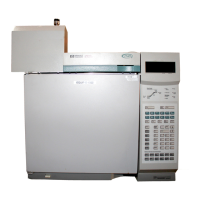
Do you have a question about the HP 6890 series and is the answer not in the manual?
| Type | Gas Chromatograph |
|---|---|
| Column Oven Temperature Range | Ambient +4°C to 450°C |
| Autosampler Compatibility | Yes |
| Maximum Temperature Ramp Rate | 120°C/min |
| Carrier Gas | Helium, Hydrogen, Nitrogen |
| Detector Options | FID, TCD, ECD, NPD, FPD |
| Inlet Options | Split/Splitless, PTV |
| Communication | RS-232 |
| Power Requirements | 50/60 Hz |
| Injection Ports | Up to 2 |
| Carrier Gas Control | Electronic Pneumatics Control (EPC) |
| Weight | Approximately 55 kg |
Covers warnings, cautions, and safety symbols for safe operation and user protection.
Explains the process of sample combustion, light emission, and detection by the photomultiplier tube.
Describes how emission intensity relates to concentration in sulfur and phosphorus modes.
Explains hydrocarbon and self-quenching, and how to reduce them with proper practices.
Details how high light intensity can saturate the PMT and the symptoms to watch for.
Describes sulfur and phosphorus filters, their colors, and transmission wavelengths.
Explains the use of inert fused silica liners for column connection and sample integrity.
Discusses optimal temperatures to prevent condensation and thermal decomposition.
Lists specific conditions like low temperature, gas flow, or ignition failure that stop detector function.
Explains how a critical gas shutdown affects the detector's operation.
Details adapters for capillary and PTFE columns to connect to the FPD.
Provides step-by-step instructions for installing fused silica columns into the FPD.
Covers mounting positions and heater assignments for single and dual wavelength FPDs.
Explains the necessity and routing of drip tubing for water vapor management.
Specifies required HP ChemStation software versions for single and dual wavelength FPDs.
Describes how AUX heater setpoints are automatically managed with the detector heater.
Step-by-step guide to adjust the Lit offset setpoint for flame detection.
Instructions to manually start the flame ignition sequence via the control table.
Explains the automatic relighting process and detector shutdown on failure.
How to turn the electrometer on or off and the implications for PMT safety.
Discusses analog output speeds and the 'fast peaks' feature for data acquisition.
Table detailing suggested gas flows and temperatures for Sulfur and Phosphorus modes.
Explains different makeup gas flow modes and how to select them.
Instructions for cleaning or replacing optical windows, filters, and seals in the FPD.